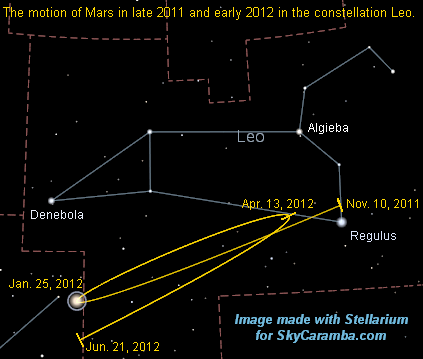SkyCaramba weekly astronomy blog for the week ending January 28, 2012
Mars is at a standstill. Not really. It just looks like that. Over the great distances of space, as the tiny dots we see as planets orbit the sun, they appear to make curved zigzags in the sky. Mars has been moving eastward since March 2010. For a little over two months, it will move westward. Then it’ll resume eastward motion which it will continue until February 2014.
If you’ve been watching Mars for a few months, you saw it in Gemini back in September. It headed to the Beehive Cluster right in the heart of the constellation Cancer in October. It kept going until it reached Leo. In early November the Red Planet passed by Regulus in the heart of Leo. After that, those watching carefully and taking good mental notes noticed it didn’t move so fast anymore.
 When a planet seems to slow down as it moves in front of the stars behind it, it’s often described as going stationary. Of course, it’s not stopping at all. But it may look that way to the casual observer. Keener observers can still recognize how it has moved from night to night. In December, Mars appeared to be moving very slowly but it has kept moving eastward until now. Astronomers call eastward motion direct motion.
When a planet seems to slow down as it moves in front of the stars behind it, it’s often described as going stationary. Of course, it’s not stopping at all. But it may look that way to the casual observer. Keener observers can still recognize how it has moved from night to night. In December, Mars appeared to be moving very slowly but it has kept moving eastward until now. Astronomers call eastward motion direct motion.
From January 25 until April 13 this year, Mars will move westward in the sky. Astronomers call that retrograde motion. You’ll see it head almost all the way back to Regulus. But as Mars starts to get close to the star, it will slow down (or go stationary) again. Then it will resume direct motion, heading eastward for almost two more years.
Planets appear to move back and forth like that not because they’re actually zigzagging in the sky. They’re actually making continuous movements in ellipses around the sun. Mars, like the others, is actually always changing direction in a constant turn. It’s like a racecar driver who’s always going forward but is always turning. Fans watching the race see him going from their right to their left, then from their left to their right, and then from their right to their left again.
What makes watching the planets move in the sky even more interesting is how the earth is going around the sun with them. We get a view of other planets like the racecar driver gets of the other racecars.
During this time when Mars is retrograde is a good time to see the planet in a telescope. It’s somewhat close to Earth and it’s up almost all night. In fact, it’ll be at opposition March 3. That’s when it is closest to Earth and up all night. When an object is closer to begin with, it will look even bigger in a telescope.